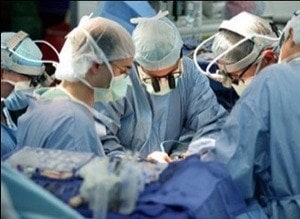Updated April 21, 2023
This page explains how the collateral source rule works in Maryland.
What Does “Collateral Sources” Mean?
 Collateral sources are payments received by the victim in a personal injury case for compensation or benefits from a party not involved in the case to compensate for the damages the plaintiff suffered in the accident or by medical malpractice.
Collateral sources are payments received by the victim in a personal injury case for compensation or benefits from a party not involved in the case to compensate for the damages the plaintiff suffered in the accident or by medical malpractice.
What Is the Collateral Source Rule?
The defendant is liable to the injured victim for their injuries, regardless of whether someone else has paid for the victim’s harm.
So the collateral source rule permits an injured person to recover the full amount of his provable damages, regardless of the amount any money the person has received for his injuries from sources unrelated to the defendant.
In 2018, the Maryland Court of Special Appeals summarized the rule as “payments made to or benefits conferred on the injured party from other sources are not credited against the tortfeasor’s liability, although they cover all or a part of the harm for which the tortfeasor is liable.”
Is the Collateral Source Rule an Evidentiary Rule?
The collateral source rule is an evidentiary rule. Because the rule bars defendants from introducing evidence to show that a plaintiff has received collateral source benefits or payments. A Maryland Pattern Jury Instruction on point defines a collateral source payment as payment from an entity “other than the defendant.” This gives you some idea of how broad the scope of the collateral source rule is.
Why Is the Collateral Source Rule Good for Victims?
So, in some cases, it permits a plaintiff to recover damages twice for some or all of their economic losses. So in a personal injury case in Maryland, the jury is not told if health insurance or worker’s compensation insurance paid all or a portion of the plaintiff’s medical bills.
The collateral source rule is now an embedded part of the law in Maryland and nearly every state in the country. When trying a personal injury case to a jury, the fastest path to a mistrial is to breathe a word about insurance.
- Origin of collateral source rule in Maryland
- Justification for rule
- Exceptions
- What insurance companies do not want you to know
- Collateral source rule and lost wages in Maryland: you might be entitled to more than you think
- ObamaCare impact of law?
- Key Maryland cases
History of the Collateral Source Rule
This Maryland rule of evidence dates back to 1899. The rule is grounded in the long-standing policy decision that should a windfall arise as a consequence of an outside payment, the party to benefit from that collateral source – that the injured party likely paid for through insurance premiums – is the person who has been injured, not the one whose wrongful acts caused the injury.
The Justification for the Maryland Collateral Source Rule
A plaintiff’s PIP, health insurance, or any other collateral source is not introduced to the jury. The jury may reduce the damages award when it discovers that another source has paid the plaintiff’s damages. Why is this a bad thing? Well, let’s spin it the other way first: why should a wrongdoer get a benefit from a collateral source of damages caused by his wrongful act? If I’m lucky enough that my boss still paid me while I was out of work because I’m a good employee and have a track record of success at my company, why should the person who hurt me get the benefit of that goodwill? Similarly, why should the negligent party benefit because I was smart enough to take out health insurance or PIP insurance? If someone is going to get a “windfall,” shouldn’t it be the victim instead of the wrongdoer?
So the collateral source rule in Maryland is an evidentiary rule that keeps out otherwise admissible evidence. The Maryland Supreme Count has summarized the doctrine by saying, “In a nutshell, the evidence, though otherwise admissible, is deemed to do more harm than good. On balance, therefore, it is out!” (a rare exclamation point in an appellate opinion).
There is also a law and economics basis for the rule as well. If the negligent party does not bear the total cost of the loss, they are incentivized to take more risks with our safety. Why not roll the dice when you only have to pay half the loss? Said differently, the collateral source rule deters future negligence by placing the total value of the loss on the party that caused the accident.
There has been a slew of recent attacks on the collateral source rule over the past few years. The main impetus behind this attack is an ostensible financial crisis in the insurance industry. (Like Hyman Roth, the insurance companies have been dying of the same disease for 20 years. Of course, they are still making billions upon billions of dollars.) This has led many state legislatures and courts to carve out exceptions to the rule, including Maryland, in malpractice cases. See below.
Exceptions to the Collateral Source Rule
Defense lawyers hate the Maryland collateral source rule and spend a lot of energy trying to run around it. Thirty-eight states recognize some exceptions to the collateral source rule. Four exceptions appear with some frequency (1) the Gladden exception, (2) the lien-reduced exception, (3) malingering exception, and, (4) the malpractice exception.

The Gladden exception to the collateral source rule in Maryland allows defendants to introduce insurance payments if they dispute the plaintiff’s claim of his financial condition. The lien reduction exception argues that if the amount that must be paid back is reduced or waived – let’s say the hospital waives the medical bill – that fact should be admissible.
The malingering exception allows for the admission of collateral sources to show the plaintiff exaggerates his injuries because h
e is getting payments to sustain him while not working. So where the defense lawyers argue malingering with only minor injuries, it may not be reversible error to allow evidence that the plaintiff’s employer was still paying him while he was off work. In these cases, the evidence of collateral source payments is admissible to establish lack of motivation to work, but not to mitigate the victim’s lost wage damages. That is a real tightrope for trial judges to walk.
Maryland courts have recognized the Gladden exception and the malingering exceptions. But it is still an uphill battle for defendants to get around the collateral source rule with these exceptions because this argument can usually be made with far less prejudicial evidence.
How Does the Malpractice Exception to the Collateral Source Rule Work?
In response to an “alleged” medical malpractice insurance crisis, the Maryland legislature modified the collateral source rule to reduce the award of damages when payments from a collateral source were available to the plaintiff.
So how it works in Maryland is collateral source evidence is still inadmissible during a medical malpractice trial. But after a verdict, the defense lawyers will ask for a remittitur to the amount the plaintiff still owes. So if a $100,000 medical lien cannot be reduced further, the judge will reduce the outstanding medical bills to $100,000 even if the total amount of medical bills awarded was much higher. So if the plaintiff has been paid, reimbursed, or indemnified pursuant to statute, insurance, or contract for all or part of the damages. The sum remitted will equal the sum received from the collateral source.
What Do Insurance Companies Not Want Victims to Know About This Rule?
It is counter-intuitive to most personal injury victims that the at-fault insurance company is still obligated to pay for lost wages when the employer continued to pay the victim or for medical bills that have been paid by health insurance or PIP insurance. So the insurance companies try to use this against you in your settlement negotiations. “Okay, I see your bills and lost wages have been paid, so that is no problem. How much do you think your injuries are worth?” This is the kind of garbage you see out of most insurance companies trying to settle cases with victims without sophisticated lawyers.
Does ObamaCare Impact the Collateral Source Rule?
Defense lawyers are scheming that ObamaCare makes healthcare coverage an obligation that nullifies the logic of the collateral source rule. Don’t be surprised to see that some Maryland legislature propose limiting medical expenses to the amount of health insurance coverage. There are many reasons why this logic fails — for one, let’s stop pretending everyone will be covered and that there is no cost to having insurance. But victims’ advocates need to be ready to fight this issue vigorously.
Hiring a Lawyer
If you have been injured in an accident in Maryland, call us at 800-553-8082 or click here for a free consultation.
More Collateral Source Resources
- Opposing view: Cato
- Dealing with Medical Liens (overview of what an assignment and authorization is and how it works)
- Sample Lost Wage Form
Maryland Collateral Source Rule Case Law
- Plank v. Summers: P.G. County car accident case is probably the most cited Maryland case supporting this rule. In this case, the Maryland high court allowed the victim to recover the value of medical and hospital services that the Navy gave gratuitously given to the injured party.
- Narayen v. Bailey: After a verdict, a doctor filed a Motion for Remittitur requesting a reduction of damages because Blue Cross Blue Shield had paid the plaintiff’s medical bills. Discusses Maryland law exception in medical malpractice post-verdict proceedings by permitting evidence of such benefits. The big key: if there is a reduction, the subrogation rights of the collateral source are eliminated. Under this scenario, the collateral source is estopped from seeking reimbursement.
- MVA v. Seidel: Nice statement of law for your brief: The collateral source doctrine permits an injured person to recover the full amount of their provable damages, “regardless of the amount of compensation which the person has received for his injuries from sources unrelated to the tortfeasor.”
 Plaintiff Attorney Legal Information Center
Plaintiff Attorney Legal Information Center